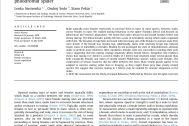Content
Males typically court females extensively to convince them to mate. In some species, however, males coerce females to mate. We studied mating behaviour in the spider Thanatus fabricii and focused on behavioural and venomic adaptations. We found that males always bit and bound females before and during mating. The bitten females quickly fell into a state of immobility, during which males copulated with them. The duration of male bites increased with increasing size of the female. In contrast, male bites were shorter if the female was missing legs. Additionally, males with relatively longer legs induced longer states of immobility in females. Binding by silk prolonged the state of immobilization, allowing males to perform more insertions. After copulation, females were less successful in catching their prey (ants), suggesting that this mating strategy negatively affects female fitness. Altogether, this evidence shows that mating in T. fabricii is coercive. Males of T. fabricii had relatively larger venom glands than both conspecific females and males of closely related Philodromus species, which court females. The composition of venom, however, did not differ between the sexes. Male venom glands appear to be adapted to coercive mating rather than to foraging, as they caught fewer prey than closely related species. We suggest that coercive mating in T. fabricii may be enabled by venomic adaptation in the males.



